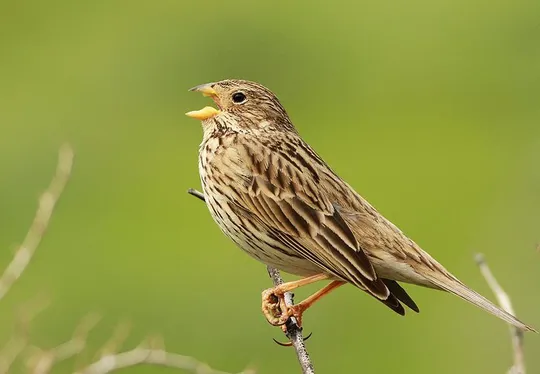Emberiza melanocephala
 Endangered
Endangered
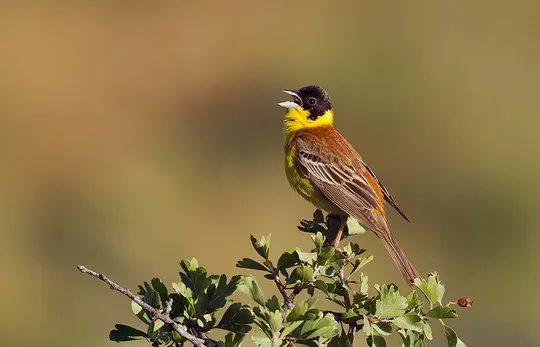
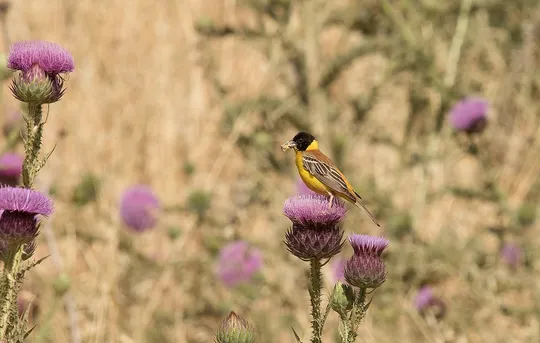

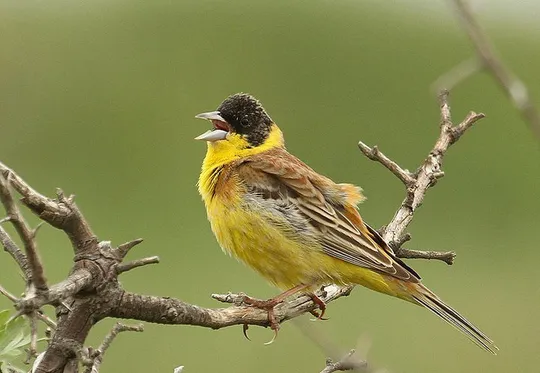
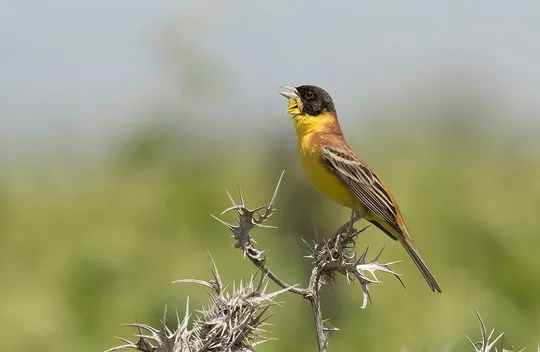
| Habitats | Mountainous Forest, Parks & Woodlands, Bush & Garrigue |
|---|---|
| Presence In Israel | Summer, Migrant |
| Breeding In Israel | Breeder |
| Migration Types | Long Range |
| Zoographical Zones | Mediterranean |
| Landscape Types | Mountainous, Plains & Valleys |
| Vegetation Types | Mediterranean Maquis, Mediterranean Garrigue |
| Vegetation Densities | Medium, Low |
| Nest Locations | Tree, Bushes |
| Diet Types | Invertebrate, Herbivore |
| Foraging Grounds | Ground, Trees and Shrubs |
| Body Sizes | Small (up to 500g) |
| Threat Factors | Pesticide Poisoning, Habitat loss and fragmentation |
The Black-headed Bunting is a medium-sized brightly colored bunting with a pleasant trilling song. The male has a black head, a yellow belly and an unstreaked chestnut colored back. The females and immatures are brown-gray and more dull.
The Black-headed Bunting is an extremely rare summer breeder and passage migrant. Its current breeding range is limited almost entirely to the northern Golan Heights and the Mt. Hermon slopes (up to an altitude of 1650 meters), and the number of individuals in these areas has decreased considerably as well. Isolated pairs still nest in the Judean Lowlands, the Bet Netofa Valley and the Eastern Galilee. It was a common summer visitor throughout most of Israel’s Mediterranean region until the 1960s. Since the late 1950s, a declining trend is apparent in its range and population size. The species has disappeared as a breeder in Judea and Samaria, the Carmel and the Western Galilee. The Eastern Galilee and Golan Heights populations have also decreased considerably and become fragmented.
The gradual decline of the Black-headed Bunting has been observed since the 1950s, and apparently is a consequence of the expansion of agricultural areas and afforestation, as well as the use of pesticides in agriculture (Paz 1986, Shirihai 1996). The species has disappeared as a breeder from extensive areas in which it was once common, including virtually the entire Galilee area, the Northern Valleys, Northern Samaria and the Judean Mountains.
The Black-headed Bunting population that nested in central Israel was apparently affected by habitat modification and destruction and by the use of agricultural pesticides. The main areas presently occupied by the species are the northern Golan Heights and the Mt. Hermon slopes. It is threatened in these areas by habitat modification resulting from development, afforestation and agricultural plantations in the northern Golan Heights, roadbuilding, ski run development and other installations on Mt. Hermon.
No specific conservation measures have been taken for this species to date.
The Black-headed Bunting is an endangered migratory species due to the drastic decline in its population size and range. In recent decades, it has receded from most of its breeding areas in Judea, Samaria, and the Galilee, and is presently breeds mainly in the northern Golan Heights and Mt. Hermon. In light of the accelerated development planned in the Golan Heights, key areas in which the species nests densely should be located, and their preservation ensured.
The Black-headed Bunting has been affected mainly by the destruction and fragmentation of shrubland and open woodland areas, as well as by the use of insecticides in agriculture. Quality breeding grounds in the northern Golan Heights, the main present habitat of the species in Israel, should be preserved.
- ישראלי, נ. ופרלמן, י. 2013. סיכום סקר עופות מקננים בחרמון. דו"ח מרכז הצפרות של החברה להגנת הטבע.
- פז, ע. 1986. עופות. מתוך אלון, ע. (עורך), החי והצומח של ארץ ישראל. כרך 6. הוצאת משרד הביטחון, ישראל.
- שוחט, א., פרלמן, י., שני, א., עובדיה, ע., ישראלי, נ., פרלמן, ג. ואלון, ד. 2009. טיבוע ציפורים ארוך טווח בחרמון: תמורות בהרכב החברה ובדינאמיקה של אוכלוסיות.
- Shirihai, H., 1996. The Birds of Israel. Academic Press, London.
- Symes, A. 2013. Species generation lengths. Unpublished, BirdLife International.
- Species page at Birdlife International
Current Occupancy Map
| Data Missing | Sporadic | Limited Sites | Low Density | High Density |
|---|---|---|---|---|
| 0 | 0 | 0 | 0 | 0 |
Distribution maps
The maps presented here provide visual information on the distribution of species in Israel from the past and present, and the changes in occupancy and breeding density during the comparison period. For further reading
Relative Abundance 2010-2020
Breeding density values in the current decade as determined from experts' opinion and observations from databases.
| Data Missing | Sporadic | Limited Sites | Low Density | High Density |
|---|---|---|---|---|
| 8 | 12 | 12 | 21 | 19 |
Relative Abundance 1980-1990
Density values based primarily on the book The Birds of Israel (Shirihai 1996).
| Data Missing | Sporadic | Limited Sites | Low Density | High Density |
|---|---|---|---|---|
| 5 | 14 | 14 | 17 | 22 |
Occupancy 1990-2020
The map shows differences in the species breeding distribution between the 1980's breeding map and the current weighted breeding evaluation. Negative value - species previously bred in the grid and is not presently breeding; positive value - species has not previously bred in the grid and is currently breeding.
| Data Missing | No Change | Occupancy Increase | Occupancy Decrease |
|---|---|---|---|
| 6 | 35 | 1 | 9 |
Change in Relative Abundance 1990-2020
The map shows the changes in the relative abundance of a species in each of the distribution grids between the breeding map of the 1980s and the weighted current breeding evaluation. Negative values - decline in abundance; positive values - increase in abundance; zero - no change in abundance.
| 80 to 100 | 50 | 20 to 30 | No Change | 30- to 20- | 50- | 100- to 80- | Data Missing |
|---|---|---|---|---|---|---|---|
| 0 | 4 | 2 | 22 | 12 | 14 | 11 | 16 |
| Rarity | |
|---|---|
| Vulnerability | |
| Attractiveness | |
| Endemism | |
| Red number | |
| Peripherality | |
| IUCN category | |
| Threat Definition according to the red book |
 Contributed:
Contributed: 

